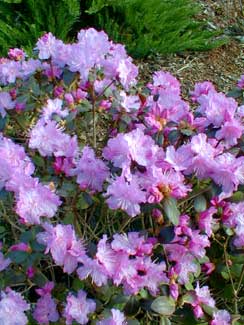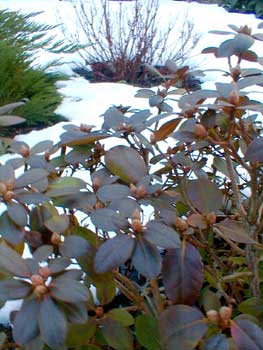
'PJM Compacta'
a Mezzit Rhododendron
"To dwell is to garden."
-Martin Heidegger
(1889-1976)
(1889-1976)
Rhododendron minus var minus (Carolinianum) x dauricum var sempervirens 'PJM Compacta' is one of several PJMs.
There is variation in them because the name PJM embodies several closely related & similar lineages developed by Peter J. Mezzit. Some have larger leaves & some such as 'PJM Elite' grow more swiftly & larger. 'PJM Compacta' has smallish round leaves & a much more compact habit than most PJMs.
 In general PJMs are semi-dwarf evergreens at only three to five feet tall in ten years, though 'PJM Elite' can be bigger, & 'PJM Compacta' can stay smaller.
In general PJMs are semi-dwarf evergreens at only three to five feet tall in ten years, though 'PJM Elite' can be bigger, & 'PJM Compacta' can stay smaller.All the PJMs are noted for their burgundy leaf-color in winter. The color they lend to the winter garden adds much to their deserved popularity. The winter leaf portrait on the right was snapped in January with snow still on the ground.
As spring progresses the leaf color will return to green. The leaves curl under around the edges, a defense mechanism that makes it difficult for insects to stand on the leaf nibbling at the edges.
Pink or lavender-pink lightly or barely scented flowers occur late winter & early spring, & can be so numerous the leaves vanish under blooms. The flower portrait here were taken early March.
Very hardy & especially cold-hardy, they can be grown further north than most evergreen rhodies. They can tolerate moderate shade but have their best winter color when in an exposed location.
In the coastal Northwest there's a slight chance of over-exposure to dessicating winter winds or harsh sun, but a few nearby shrubs of about the same size will be sufficient protection.
In colder zones a PJM may require more careful positioning so as not to be greatly exposed to winter winds. When grown inland they may prefer dappled sunlight or semi-shade. They're fairly forgiving of imperfect conditions so long as they do not experience too much wetness nor lengthy drought, wanting moist well-draining soil.